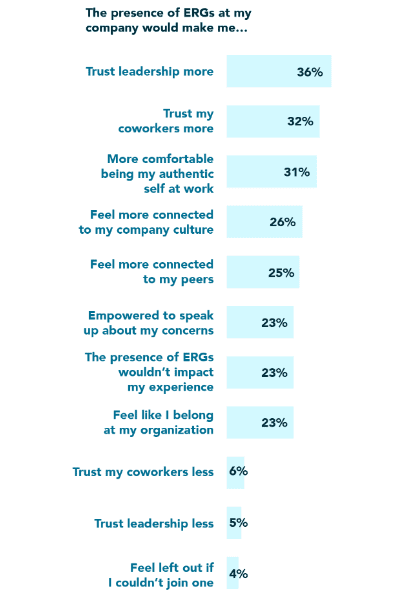What is an Employee Resource Group?
Dive into the realm of Employee Resource Groups, or ERGs. These voluntary assemblies, driven by employees, champion diversity and inclusion in the workplace. Typically, ERGs concentrate on particular dimensions of diversity, from race and gender to age, disability, and more. Their purpose? Foster a community spirit among employees of similar backgrounds, offer resources, and raise awareness on inclusion topics.
Beyond serving the individual, ERGs bring significant advantages to the organization. They provide unique insights, promoting an inclusive work culture. This often translates to better employee retention, satisfaction, and an enhanced ability to attract a diverse talent pool.
While ERGs focus on specific groups, participation remains open for all. It’s crucial for companies to ensure ERGs are welcoming and encompassing. This involves offering necessary support, such as leadership endorsement or logistical backing.
That’s said, ERGs are essential instruments in cultivating community and advancing diversity in a corporate setting. Delve deeper to uncover how they can enrich your organization.
Why are ERGs important?
Employee Resource Groups (ERGs) aren’t just organizational buzzwords; they play a pivotal role in the corporate landscape. Here’s why:
At their core, ERGs offer employees a unique sense of belonging and camaraderie. They create an environment where individuals connect over shared identities or experiences, enhancing community feelings within the workplace. This environment, in turn, boosts employee retention and satisfaction rates.

Furthermore, the diversity within ERGs offers organizations a fresh lens through which they can view and address diversity and inclusion challenges. When employees from varied backgrounds converge, they bring together a mosaic of insights. These perspectives can guide organizational policies, ensuring workplaces are not only diverse but truly inclusive.
From a talent perspective, ERGs act as magnets, drawing in and retaining diverse professionals. Many candidates prioritize organizations that champion diversity and offer robust support structures for underrepresented groups. By emphasizing these values, companies can assure a talented, diverse workforce that aligns with the diverse needs of clients and stakeholders.
Thus, ERGs do more than support employees; they enrich the organizational fabric by promoting community, inclusivity, and a diverse talent pool.
How do I Initiate an Employee Resource Group (ERG) in my Company?
Thinking of launching an ERG in your workplace? Here’s a concise guide to get you started:
1. Assess the Need. Begin by evaluating the existing diversity in your company. Are there specific groups underrepresented or lacking visibility in leadership roles? This will help determine the relevance of an ERG.
2. Define Objectives. Decide on the core mission of the ERG. Whether it’s for networking, advocacy, professional growth, or raising awareness about inclusivity, having clear goals is crucial for the group’s success.
3. Gather Enthusiasts. With a clear vision, reach out to potential members. Leveraging social media or internal company platforms can be effective in this recruitment phase.
4. Strategize Activities. Brainstorm and decide on impactful events or initiatives that align with the ERG’s mission. This could range from workshops, networking sessions, or awareness campaigns.
5. Engage Leadership. Secure endorsement and backing from the company’s leaders. This support can be in the form of funding, logistics, or even having an executive sponsor to champion the ERG’s cause.
Sometimes, you might also encounter people with these types of concerns. Such as the question below:
Q: I’m keen on supporting our diverse employees, but how can we avoid making our company overly political or appearing too ‘snowflake’?
A: This is a valid concern and is shared by many. It’s important to remember that fostering an inclusive environment doesn’t equate to being political; it’s about promoting mutual respect, understanding, and teamwork among all employees.
Here’s a perspective on striking that balance:
1. Distinguishing Support from Politics. We can celebrate diversity without taking a political stance. Simple gestures, like acknowledging various cultural holidays, conducting cross-cultural workshops, or creating Employee Resource Groups (ERGs) can make a significant difference. These ERGs can be places of open dialogue without making participation mandatory.
2. Reframing the ‘Snowflake’ Perception. The term “snowflake” can imply fragility, but it’s essential to respect and validate everyone’s experiences. By prioritizing empathy and open communication, we can create an environment where everyone feels valued and understood, while still focusing on the company’s core objectives.
3. Maintaining Core Values. The key is to integrate inclusivity into the company’s existing values, not to change them. This ensures that while we respect and understand each other’s differences, our primary mission and company objectives remain clear.
Ultimately, the goal is to foster a workplace where everyone feels they belong and can contribute their best, without the discussions becoming divisive.
What Activities do ERGs do?
1. Networking Events, Collaborative Projects & Social Events
ERGs often host networking events to allow members to forge connections, exchange experiences, and bolster mutual encouragement. These can range from casual meet-ups to more structured workshops or speaker sessions. To successfully orchestrate a networking event:

1.1 Define Objectives. Understand the main aim of the event. Is it about sharing experiences, building skills, or broadening networks? You can consider things like organizing casual get-togethers, movie nights, or book clubs centered around themes relevant to the group, promoting camaraderie.
1.2 Event Structure. Decide if it’s going to be a relaxed meet-and-greet, a mentorship meetup, a seminar, or any other format.
1.3 Engage Experts. Look for seasoned professionals or experts in desired areas to act as facilitators or speakers.
1.4 Logistics Planning. Choose an accessible location and a suitable date considering the availability of most attendees.
1.5 Event Promotion. Use a mix of email, social media, and internal communication channels to advertise the event.
1.6 Budgeting and Resources. Check if there are any costs involved, such as venue rental, refreshments, or speaker fees, and plan accordingly.
1.7 Gather Input. Engage potential attendees before the event to understand their expectations.
1.8 Collaboration. Team up with other ERGs or organizational units for a broader reach and richer content.
1.9 Preparation. If it’s a workshop or seminar, ensure content is well-prepared in advance.
1.10 Interactive Elements. Spice up the event with Q&A sessions, group activities, or fun icebreakers to keep engagement high.
1.11 Post-event Connections. Consider creating a platform for attendees to continue interactions and discussions after the event.
1.12 Feedback. After the event, solicit feedback to gain insights into improvements for future events.
The objective is to curate an environment conducive to genuine connections and professional growth while championing an inclusive organizational culture. You can also consider using tools in Slack or Microsoft Teams to automatically match people from the same ERGs or different ERGs for virtual coffee chat. LEAD.bot for Slack and LEAD.bot for Microsoft Teams can automatically match employees 1:1 or in small groups while handling people opt-in and out freely, as well as collect feedback from each individual anonymously. Read more about LEAD.bot matching here.
2. Professional Development Workshops & Mentoring and Sponsorship Programs
- Tailored to address unique challenges faced by specific groups, these workshops might cover topics like leadership training, soft skill enhancement, and career growth strategies.
- Pairing younger or less experienced group members with senior members or allies for guidance and career advancement. You can also check out tools such as LEAD.bot for new hire onboarding as well as speed mentorship pairing.
3. Cultural Celebrations
Recognizing and celebrating significant cultural or identity-specific holidays and events, fostering a sense of belonging and educating the wider workforce about different cultures and traditions.
4. Recruitment Initiatives
Collaborating with HR to attract diverse talent by attending job fairs, university events, or partnering with diversity-focused organizations.
5. Community Outreach & Awareness Campaigns
Initiatives aimed at educating the wider organization about the experiences, challenges, and contributions of specific groups. Volunteering or fundraising for causes relevant to the group’s identity or interests, thereby linking the company to the wider community.
6. Policy Advocacy
Working with leadership to ensure that company policies are inclusive, and voicing concerns or recommendations when they aren’t.
7. Roundtable Discussions
Hosting regular discussions on pertinent topics, which can be a platform for members to voice their experiences, share challenges, and brainstorm solutions.
8. Feedback Channels
Establishing regular channels for members to provide feedback on organizational practices, which can be used to make the workplace more inclusive.
These activities not only serve to support and uplift members of the ERGs but also play a crucial role in shaping a more inclusive and understanding company culture.
How are Employee Resource Groups Governed?
The way ERGs operate and are managed can differ based on an organization’s size, the ERG’s objectives, and organizational needs. Nevertheless, there are common governance features prevalent across many ERGs.
1. Leadership Framework
Most ERGs have a leadership committee that steers its course. This could encompass positions such as a chairperson, vice-chair, secretary, and treasurer. The selection process for these roles often involves elections within the ERG, with representatives serving predetermined tenures.
2. Mission and Vision
An ERG is typically anchored around its mission and vision statements. These articulate the group’s core objectives and act as a compass for its activities and initiatives. Whether crafted by the leadership or the collective membership, these statements clarify the ERG’s raison d’être.
3. Key Guiding Principles Include
- Diversity and Inclusivity Advocacy: Endeavoring to establish an inclusive workplace that respects diverse identities.
- Community Building: Offering a nurturing environment to foster unity and mutual support among ERG members.
- Professional Growth: Enabling members to hone skills and grow professionally.
- Change Champions: Drawing attention to pertinent issues and championing policies endorsing diversity and inclusiveness.
- Cross-organizational Collaboration: Forging alliances within the organization and extending engagement to external communities when relevant.
- Ethical Operations: Upholding transparency, integrity, and being answerable to members and the larger organization.
4. Bylaws and Operational Guidelines
To maintain consistency and clarity in operations, ERGs might have bylaws detailing the group’s operational nuances. This could range from leadership election modalities, defined responsibilities of office bearers, to blueprints for orchestrating events.
5. Specialized Committees
Depending on the ERG’s breadth and depth, specialized committees might be formed. These can cater to niche areas such as skill development, community outreach, or publicity efforts.
In essence, the structured governance of an ERG ensures its efficient functioning while staying aligned with its founding objectives and the larger organizational ethos. Such a framework allows the ERG to leave a lasting and meaningful imprint in the corporate landscape.
Conclusion
Employee Resource Groups (ERGs) are self-organized, employee-driven collectives aiming to accentuate diversity and inclusivity within an organization. They serve as a beacon for individuals sharing common backgrounds or identities, fostering a deeper sense of community and connection. While ERGs are tailored for specific identities, it’s paramount that the doors are kept open to all interested employees, cementing the very essence of inclusivity.

Beyond just the individuals, ERGs serve a dual purpose, benefiting the organization as well. They act as pivotal instruments in heightening employee morale, retention, and playing a vital role in magnetizing diverse talents to the company. When ERGs amplify the principles of unity, support, and diversity, the ripples are felt across the organizational fabric, nurturing a culture that truly values inclusiveness.
For ERGs to be genuinely impactful, it’s vital that they are backed by both budgetary allocations and executive sponsorship. This ensures that their initiatives are not just well-intentioned but are effectively executed. Proper funding and leadership support further legitimizes the ERG’s role within the organization, providing them the necessary resources and influence to drive meaningful change.
To further refine the dynamics of your ERG, consider integrating LEAD.bot. This tool can seamlessly connect members, encouraging them to engage in meaningful interactions. Such initiatives not only deepen the ties within the ERG but can also expand to encompass the broader organization. Envision the empowerment when employees effortlessly bond over shared experiences or backgrounds – a surefire strategy to solidify relationships and fortify support structures.
FAQ
Are Employee Resource Groups effective?
Employee Resource Groups (ERGs) have demonstrated their significance in multiple contexts. They create platforms for members to find community and mutual support, which in turn enhances employee engagement and loyalty. Through ERGs, employees often channel their passion for advocating for diversity, helping to cultivate a more inclusive organizational atmosphere.
Beyond being a meeting point for like-minded individuals, ERGs also offer organizations unique perspectives and insights, frequently acting as engines for innovation and unconventional solutions.
However, it’s essential to understand that while ERGs can be powerful, they also come with challenges. Employees who participate in ERGs report higher levels of stress. Recognizing and effectively rewarding them for their contributions can counterbalance this stress. Notably, our research with Gallup has highlighted the power of recognition. Nearly three-fourths (72%) of employees who receive “great” recognition report they’re thriving overall.

To maximize the potential of ERGs, robust organizational support is crucial. This encompasses not just moral support but also tangible resources and funding. While ERGs play a pivotal role in promoting diversity and inclusivity, they shouldn’t be perceived as the only avenue for such initiatives. They should be seen as an enhancement to wider organizational diversity and inclusion strategies. With the right support and recognition, ERGs can propel organizations towards a harmonious, diverse, and forward-thinking future.
What is the difference between Employee Resource Groups and Affinity Groups?
Employee Resource Groups (ERGs) and affinity groups both originate from a desire to foster community among employees with shared identities or experiences. Yet, they have distinct characteristics in terms of origin, structure, and purpose.
Origin and Sponsorship. ERGs are generally organizationally-sponsored entities. This means they are recognized, supported, and often funded by the organization itself. In contrast, affinity groups usually emerge organically from employee initiatives. They are grassroots groups formed and run by employees based on shared interests or characteristics.
Structure. ERGs often have a more formalized structure. They might have designated leaders, regular meetings, and clearly defined objectives that align with organizational goals. Affinity groups, conversely, can be more informal. Their activities might be more spontaneous, and they may not have as rigid a hierarchy or structure as ERGs.
Scope and Focus. While both groups are centered around shared characteristics or experiences, ERGs typically have broader objectives. They not only provide support and community for their members but also often drive organizational initiatives around diversity, equity, and inclusion. They might collaborate with HR for recruitment, retention, and promotion of diverse talent or help in setting up diversity training sessions. Affinity groups, however, are primarily centered on building community and offering support. Their activities might be more social or support-focused rather than strategically aligned with broader organizational goals.
Membership. ERGs, being organization-sponsored, are usually open to all employees who are interested in joining, regardless of whether they personally identify with the group’s main characteristic. The idea is to foster allyship. Affinity groups might be more exclusive, catering primarily to employees who share the group’s core identity or interest.
In essence, while both ERGs and affinity groups play crucial roles in enhancing the workplace experience for diverse groups of employees, they differ in origin, structure, and purpose. Organizations benefit from understanding and supporting both types of groups to foster a truly inclusive environment.
What are the typical roles and responsibilities within an Employee Resource Group, and how do they contribute to the group’s objectives and the broader goals of the organization?
In employee resource groups (ERGs), various roles and responsibilities are designed to ensure that the group runs effectively and meets its objectives. Here’s a refined description of common roles found within ERGs:
Chair or President: The individual in this role typically leads the ERG. They set the strategic direction, coordinate with other organizational leaders, and ensure the group meets its objectives. They often lead meetings and serve as the primary representative of the ERG to external stakeholders.
Vice Chair or Vice President: This person supports the Chair in their duties and often steps in during their absence. They may also take the lead on specific projects or initiatives.
Secretary: This role involves managing group records, taking minutes during meetings, and handling some of the group’s communications.
Treasurer: If the ERG has a budget, the Treasurer manages it. This includes tracking expenditures, requesting funds, and reporting on financial status.
Executive Sponsor: Usually a senior leader from the organization, the Executive Sponsor provides advocacy for the ERG at higher levels within the company. They help secure resources and give strategic guidance, ensuring alignment with the organization’s overall goals.
Committee Leads: For ERGs that have sub-committees focused on specific initiatives (e.g., events, advocacy, community outreach), there will be committee leads or chairs responsible for those areas.
Membership Coordinator: This role is centered around recruiting new members, managing the member list, and ensuring active participation within the group.
Communications or PR Lead: This individual handles the group’s internal and external communications, which may include newsletters, social media, or liaising with corporate communications teams.
General Members: These are the core of the ERG, employees who join to be part of the group. While they may not have formal leadership roles, they actively participate in events, provide feedback, and may volunteer for specific tasks or projects.
Mentorship or Professional Development Lead: If the ERG has initiatives around mentoring or career development, there might be a designated lead to coordinate such programs.
The exact roles within an ERG can vary based on the group’s size, focus, and the organization’s needs. It’s also important that roles are periodically reviewed and adjusted as the group evolves and grows.







